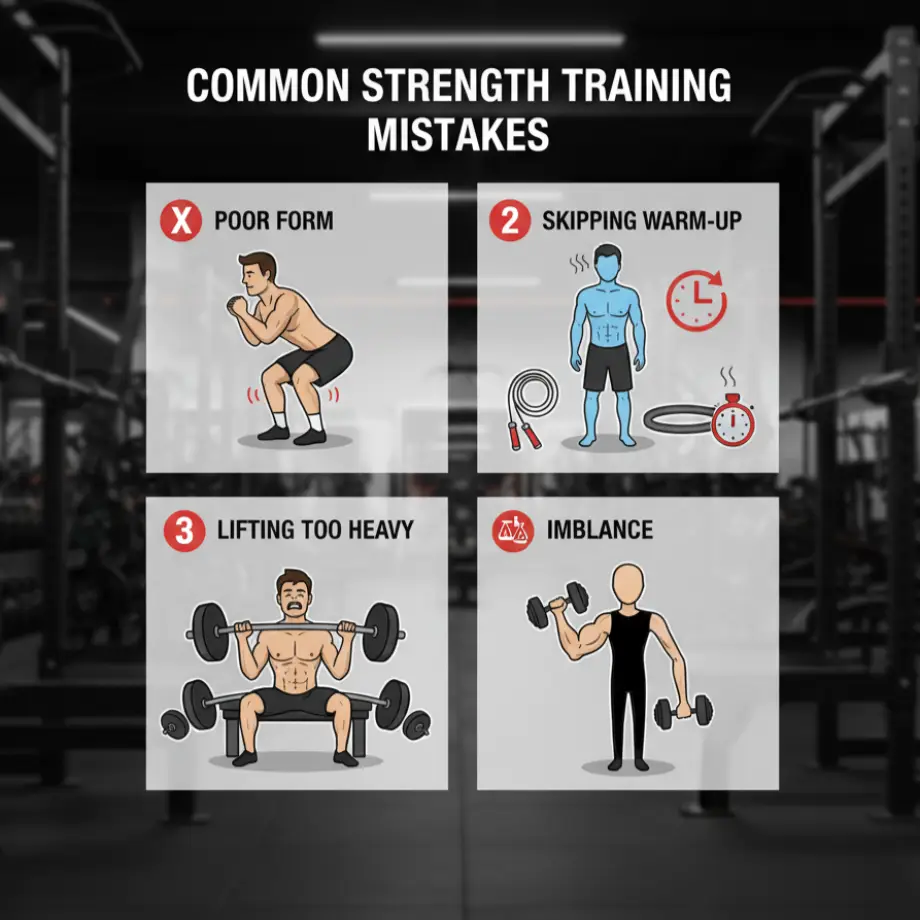Strength training builds muscle, boosts metabolism, and improves long-term health. Yet beginners often repeat the same common strength training mistakes that lead to stalled progress or injuries. From skipping warm-ups to using poor lifting form, these errors are easy to fix once you know what to look for. This guide breaks down the most frequent beginner workout mistakes, explains the science behind them, and provides simple corrections. By avoiding these gym errors and focusing on proper technique, nutrition, and recovery, you can achieve safe, sustainable gains. Let’s look at the mistakes holding back new lifters and how to correct them.

Table of Contents
Beginner Workout Mistakes That Slow Progress
Skipping Warm-Up and Cool-Down
A common mistake beginners make is heading straight to the weights without preparing their muscles. Warming up raises body temperature, activates joints, and primes muscles for heavy work. Studies show a proper warm-up can reduce injury risk by up to 30%. Skipping cooldowns is another beginner workout mistake. Without a cooldown, lactic acid builds up, leading to more soreness and slower recovery. A quick dynamic warm-up followed by five minutes of stretching at the end prevents both issues.
Doing Too Much Too Soon
New lifters often confuse effort with progress. Training hard every day without rest feels productive, but it’s one of the fastest ways to hit burnout. Overtraining leads to fatigue, hormonal imbalance, and even injuries. Beginners should aim for 3–4 structured strength sessions per week, balanced with recovery. A gradual progression plan like a Beginner Strength Training Plan prevents injury while delivering steady results.
Lifting Form Errors That Lead to Injury

Poor Squat and Deadlift Technique
Squats and deadlifts are king, but they’re also where beginners commit major lifting form errors. Rounding the back, letting knees cave in, or bouncing at the bottom puts joints at risk. Correcting these issues starts with bracing the core, keeping a neutral spine, and maintaining knee alignment. Lifting less weight with good technique beats ego lifting with poor mechanics every time.
Improper Dumbbell and Barbell Use
Beginners often swing dumbbells or drop barbells with little control. These mistakes not only waste energy but also increase the chance of injury. Proper form for lifting dumbbells means controlled tempo, neutral grip, and engaging stabilizer muscles. For beginners using barbells, start with an empty bar to lock in movement patterns before loading weight. Our guide on Dumbbell Strength Training covers proper technique in detail.
Gym Errors in Workout Programming
Ignoring Compound Movements
Many new lifters focus on isolation work like bicep curls while neglecting compound exercises. This is one of the biggest gym errors because compound lifts recruit multiple muscle groups, build strength faster, and burn more calories. Squats, presses, rows, and deadlifts should form the foundation of any beginner’s plan. Isolation lifts can add shape, but they should never replace the basics.
Failing to Follow a Structured Plan
Jumping into random workouts without progression is another trap. Without a plan, beginners often repeat the same weights for months with little change. Structured programs use progression principles, gradually increasing weight or volume. Following a plan like our Full Body Strength Training blueprint ensures balanced growth and measurable progress.
Nutrition and Recovery Mistakes
Underestimating Protein and Calories
Training without proper nutrition is like driving a car without fuel. Many beginners undereat, assuming less food means more fat loss. In reality, strength training demands higher protein intake to repair muscle tissue. Research suggests 1.6–2.2g of protein per kilogram of bodyweight is ideal. Balanced carbs and fats are also key. Training hard on a calorie deficit without planning often leads to fatigue and stalled strength gains.

Neglecting Recovery and Sleep
Recovery is the secret ingredient most beginners overlook. Muscles grow outside the gym, not during training. Poor sleep and skipped rest days reduce strength, motivation, and hormone balance. Prioritizing recovery with 7–9 hours of sleep and active recovery days prevents overtraining. Learn more with our Strength Training Recovery guide.
Gender-Specific Strength Training Misconceptions
Weight Lifting for Beginners Female
A persistent myth is that women will become bulky if they lift weights. This is false. Women have significantly lower testosterone levels than men, making bulky muscle gain extremely difficult. Strength training benefits women by building lean muscle, improving bone density, and aiding fat loss. A beginner-friendly guide like Strength Training for Women Beginners helps women start confidently.
Weight Lifting for Beginners Male
Men often fall into the trap of ego lifting. Focusing on heavy weights with poor form, or skipping leg training entirely, leads to imbalances and injuries. A balanced routine that includes both upper and lower body ensures steady, safe progress. Men should prioritize proper technique over chasing numbers too quickly.
How to Avoid Injury in Strength Training
Rushing Through Reps Without Control
Speed often becomes a silent enemy in the gym. Beginners who rush through reps lose tension on the muscles and increase joint stress. Controlled tempo ensures both muscle growth and joint safety. For example, lowering weights over 2–3 seconds builds more strength than dropping them quickly.
Ignoring Warm-Up Sets and Mobility Work
Even experienced lifters can hurt themselves by skipping warm-up sets. Loading the bar heavy without preparing muscles and joints is risky. Mobility drills and light warm-up sets activate stabilizers and prevent strains. Spending 10 minutes here saves months of injury downtime. Our How to Avoid Injury in Strength Training strategies emphasize safe progression.
Cardio, Cycling, and Cross-Training Mistakes
Common Mistakes People Make When Cycling
Cycling is a great complement to lifting, but beginners often overdo it. Poor bike posture, incorrect saddle height, and excessive mileage without recovery stress joints. Like strength training, balance is key.
Neglecting Balance Between Cardio and Strength
Too much cardio without enough lifting reduces muscle gains. On the other hand, avoiding cardio completely impacts cardiovascular health. Understanding the balance between Strength Training vs Cardio allows beginners to progress in both areas safely.
Maximizing Weight Training Benefits
The Role of Progressive Overload
Without progressive overload, strength plateaus. This principle means gradually increasing resistance, reps, or sets over time. Beginners should track lifts weekly and push for small improvements. Our Progressive Overload for Beginners explains how to apply this method safely.
Training Variety with Dumbbells and Bodyweight
Beginners often think progress requires expensive machines, but dumbbells and bodyweight exercises can build serious strength. Bodyweight Strength Training offers flexibility, while dumbbell training improves stability and range of motion. Adding variety prevents boredom and builds functional strength.
Conclusion: Key Takeaways for Safe and Effective Training
Strength training is one of the best tools for health, but only when done correctly. Avoid beginner workout mistakes like skipping warm-ups, lifting with poor form, and neglecting recovery. Focus on compound lifts, structured progression, balanced nutrition, and proper sleep. Whether male or female, your results depend on consistency, smart planning, and respect for technique. The sooner you eliminate these common strength training mistakes, the faster you’ll see lasting progress in strength and confidence.
FAQs
Common strength training mistakes for beginners
Skipping warm-ups, lifting too heavy, using poor form, and ignoring structured programs are the top mistakes beginners should avoid.
Weight lifting for beginners female
Women benefit from strength training with fat loss, stronger bones, and lean muscle. Myths about becoming bulky are false.
Disadvantages of weight training
If done incorrectly, weight training can cause injuries, imbalances, and fatigue. Following proper technique prevents these disadvantages.
Weight lifting exercises
Best beginner-friendly lifts include squats, deadlifts, bench press, rows, and controlled dumbbell movements.
Weight lifting for beginners male
Men should avoid ego lifting, balance training between muscle groups, and focus on proper form.
Common mistakes people make when cycling
Cyclists often overestimate calorie burn, ignore posture, and push mileage without recovery.
Proper form for lifting dumbbells
Use controlled tempo, neutral grip, stable shoulders, and engaged core to prevent injury.
Weight training benefits
Strength training builds lean muscle, burns fat, improves posture, strengthens bones, and prevents injuries.
Visit my Instagram account for more
